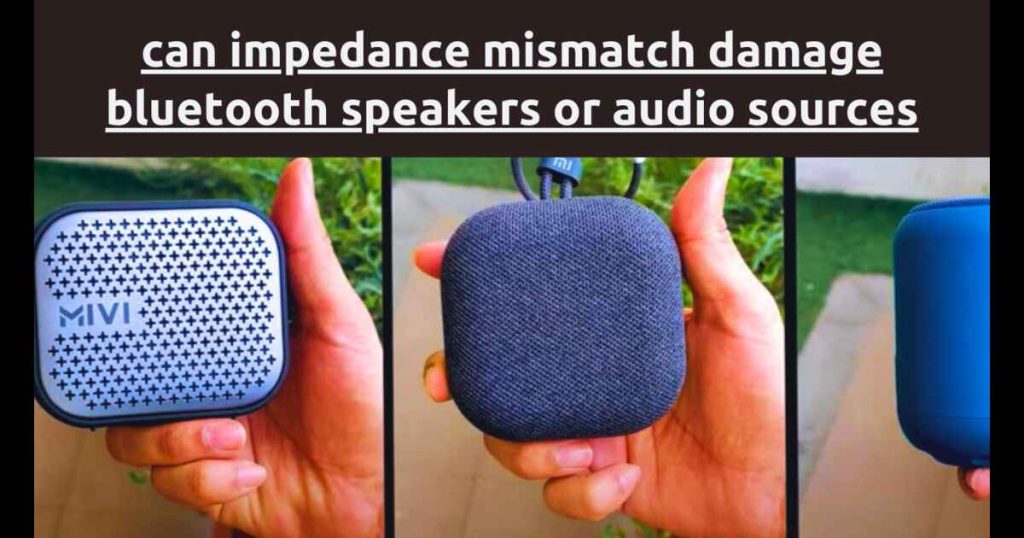
In the realm of audio equipment, the importance of matching impedance between devices, especially when connecting Bluetooth speakers to amplifiers or audio sources, is a topic that often sparks concern among enthusiasts.
The potential risks associated with impedance mismatch warrant a closer examination to understand whether such discrepancies can truly damage Bluetooth speakers or their connected audio sources. In this article, we delve into the complexities surrounding impedance mismatch and its implications for both Bluetooth speakers and audio sources.
Also read our comprehensive guide on impedance of Bluetooth speaker and How to Measure Impedance in Bluetooth Speakers at Home.
Can Impedance Mismatch Damage Bluetooth Speakers or Audio Sources?
Have you ever wondered if your trusty Bluetooth speakers or other audio gadgets could get hurt by something called “impedance mismatch”? It’s like when things don’t quite fit together in the electrical world of music. But don’t worry, we’re here to uncover whether this mix-up could cause trouble for our favorite music companions.
Impedance is like the puzzle piece that needs to fit just right between our speakers and the power they get from our devices. But sometimes, when the pieces don’t match up perfectly, it’s called “impedance mismatch.” We’re here to explore if this electrical mix-up might actually cause harm to our beloved Bluetooth speakers or other audio sources.
Join me on this journey into the tech side of sound to discover if impedance mismatch could really make trouble for our music gadgets. Let’s dive in and uncover the secrets of how our speakers and devices play together in the electrical world of music!
Understanding Impedance Mismatch
Embarking on the intricate path of audio connections, let’s unravel the enigmatic realm of ‘Impedance Mismatch’.
Defining Impedance Mismatch
Impedance mismatch occurs when the impedance of a Bluetooth speaker differs significantly from the impedance intended for the amplifier or audio source. This discrepancy can lead to potential issues in audio playback.
Effects on Sound Quality
Impedance mismatch might result in poor audio quality, characterized by distortion, reduced volume, or altered frequency response. However, the risk of physical damage to the speakers or sources due to mismatch remains a point of contention.
Exploring Potential Risks
Delving into the realm of uncertainties, let’s navigate through the potential risks lying within.
Risks to Bluetooth Speakers
While impedance mismatch can affect sound quality, the risk of immediate damage to Bluetooth speakers due to mismatched impedance is relatively low. Most modern speakers have built-in protection mechanisms.
Amplifier and Source Risks
On the other hand, amplifiers or audio sources might face more significant risks when driving speakers with significantly lower or higher impedance than intended. Overloading the amplifier could potentially lead to damage.
Factors Influencing Risk
Magnitude of Mismatch
The extent of impedance mismatch plays a crucial role. Slight variations might result in minor sound quality issues, while substantial disparities could pose higher risks.
Duration of Operation
Continuous operation under impedance mismatch conditions might exacerbate the risks. Prolonged use could potentially strain amplifiers or sources.
Mitigation and Prevention
Seeking Compatibility
Selecting Bluetooth speakers compatible with the amplifier’s or source’s intended impedance range minimizes the likelihood of mismatch-related issues.
Protective Measures
Modern audio devices often incorporate protection circuits to mitigate potential damage caused by impedance mismatches, offering a degree of safeguarding against severe consequences.
Conclusion: Balancing Risks and Precautions
In conclusion, while impedance mismatch between Bluetooth speakers and audio sources can affect sound quality, the risk of immediate damage to the speakers due to mismatch is relatively low in most cases.
Understanding the implications of impedance mismatch allows users to take preventive measures, such as selecting compatible devices and being cautious during prolonged operation under mismatch conditions. Employing compatible equipment and exercising prudent usage practices help strike a balance between enjoying audio quality and minimizing potential risks associated with impedance mismatch in Bluetooth speakers and audio sources.
